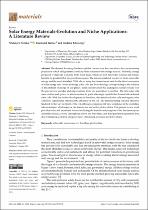| dc.contributor.author | Seroka, Ntalane S. | |
| dc.contributor.author | Taziwa, Raymond | |
| dc.contributor.author | Khotseng, Lindiwe | |
| dc.date.accessioned | 2022-09-13T07:54:06Z | |
| dc.date.available | 2022-09-13T07:54:06Z | |
| dc.date.issued | 2022 | |
| dc.identifier.citation | Seroka, N. S. et al. (2022). Solar energy materials-evolution and niche applications: A literature review. Materials, 15(15), 5338. https://doi.org/10.3390/ma15155338 | en_US |
| dc.identifier.issn | 1996-1944 | |
| dc.identifier.uri | https://doi.org/10.3390/ma15155338 | |
| dc.identifier.uri | http://hdl.handle.net/10566/7873 | |
| dc.description.abstract | The demand for energy has been a global concern over the years due to the ever increasing
population which still generate electricity from non-renewable energy sources. Presently, energy
produced worldwide is mostly from fossil fuels, which are non-renewable sources and release
harmful by-products that are greenhouses gases. The sun is considered a source of clean, renewable
energy, and the most abundant. With silicon being the element most used for the direct conversion
of solar energy into electrical energy, solar cells are the technology corresponding to the solution
of the problem of energy on our planet. Solar cell fabrication has undergone extensive study over
the past several decades and improvement from one generation to another. | en_US |
| dc.language.iso | en | en_US |
| dc.publisher | MDPI | en_US |
| dc.subject | Solar cells | en_US |
| dc.subject | Semiconductor | en_US |
| dc.subject | Thin films | en_US |
| dc.subject | Photovoltaic | en_US |
| dc.subject | Solar energy | en_US |
| dc.title | Solar energy materials-evolution and niche applications: A literature review | en_US |
| dc.type | Article | en_US |

